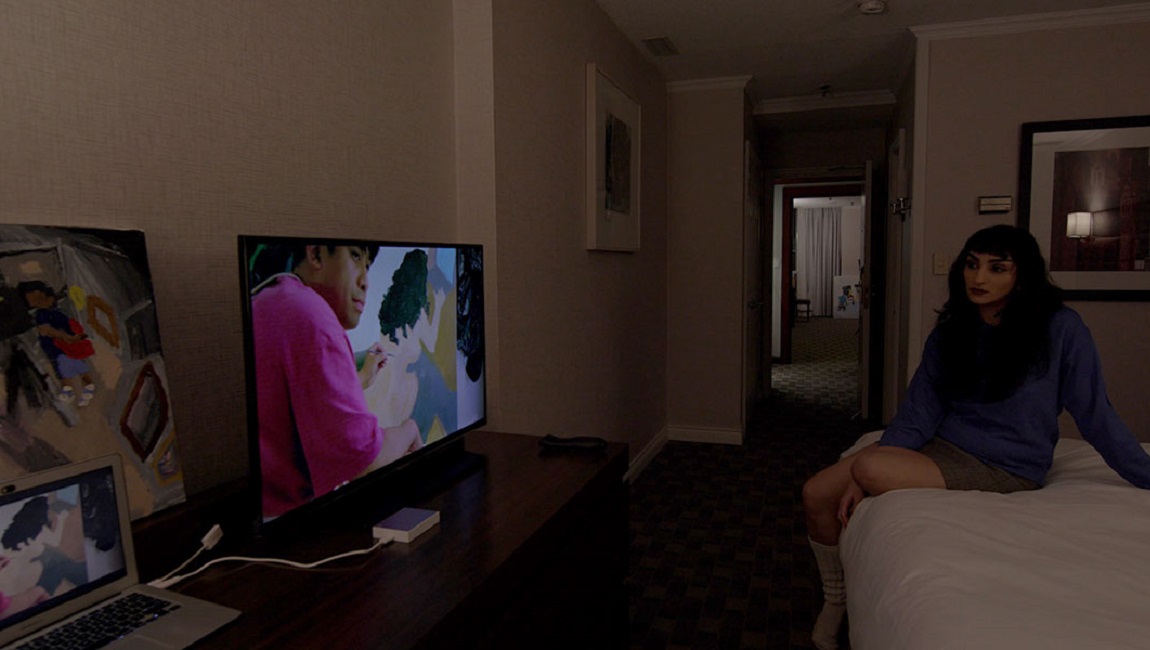Before He Thought He Died (2023), a friend spoke on his misgivings about 88:88 (2016), Isaiah Medina’s hitherto best-known film, echoing sentiments that sounded familiar. He remarked that the film’s reflection on poverty was ironic, given that its reliance on academic language rendered it inaccessible to the majority of people, and thus, the majority of poor people. Striding ebulliently on stage and ending our conversation, Medina opted for a brief introduction of his latest film: “I don’t have much to say, because I don’t think cinema is a linguistic medium.”
Medina makes film as film criticism, somewhat obviating the written word, much less the festival dispatch, as a viable path into his own work. Nevertheless, a spare plot synopsis is in order to suggest the film’s shape, and introduce some thematic concerns. He Thought He Died is about two characters. The first, a painter portrayed by Medina, stages a heist of his paintings from an art museum. The second, a filmmaker portrayed by Kelley Dong, fellow director and critic, is shooting a film in that same museum. This skeletal action is interspersed with dialogues in hotel rooms on subjects like film form, aesthetics, and morality. To judge from the timing of the film’s not insignificant amount of walkouts, it’s these dialogues that prove to be the breaking point for audiences.
Before arriving there, however, it would do well to enumerate Medina’s exhilarating formal approach. Few filmmakers have adapted Kuleshov’s doctrine to the digital age with such rigor. Phil Coldiron, Medina’s greatest interpreter, noted that Inventing the Future (2020), which is available for free download on the Quantity Cinema website, almost begs to be dropped into a digital editing suite to be fully perceived. The most salient quality of Medina’s sequences is their density: of image and meaning. They strain the bounds of what an audience can perceive in real time. He Thought He Died actually decelerates this breathless pace, to an extent. In the new film, the 24 frames per second dogma is stretched graphically, as well as temporally. Desktop screens, GUIs, camera displays, and four-quadrant canvas frames subdivide nearly all of the images in He Thought He Died. This fracturing principle is accentuated by the subject of much of the film’s visual attention: the daily work of art conservation underwent by Medina’s character’s paintings at the museum. We hear the snap of latex gloves, the masking tape, the specially fitted bits of styrofoam, and the scanning of barcodes, each essential to sealing art away.
Turning to the dialogues, there would then seem to be a contradiction between a film concerned with art’s seclusion from society, and a film that prominently features the type of heady intellectual discourse likely to reinforce the most narrow-minded conceptions of inaccessible experimental cinema. Medina cuts between Dong and a conversation partner (Myles Taylor, Alexandre Galmard, and Andilib Khan, at different points), flickering the lighting and snapping to new perspectives as the speakers bounce maxims off one another. “The good is the master where evil’s close-up is located, and even if the master is not made, it is presupposed,” Dong says at one point. At another, Medina subtracts their words in favor of a section of composer Kieran Daly’s “Two Voice Ho – Ha – Hee Heterophony For Synthesized Speech 2022,” indicating that he’s not unaware of the dialogue’s potential for opacity.
For myself, taken in whole or part, these sections don’t coalesce, nor could I venture even a preliminary reading of some sort of overarching meaning that I could extract or synthesize in words. But certain snatches provoke flights of intrigue. “I can imagine a planetless art, but an artless planet is much more frightening,” stuck with me for much of the film. Preserving art for posterity entails the jettison of much of its context. To that end, the best sequence in He Thought He Died is an interruption of the film’s overarching sterility, when Medina pivots to a montage of home video clips stretching back over a decade, from his adolescence in Winnipeg through his college years at Concordia. The warm tide of pixelated camcorder footage suddenly reveals the close interdependence of art and context.
This is all to say, the gap between Medina’s scope and his audience, as remarked upon by that aforementioned friend, is not a blind spot for the filmmaker. Though his films can be unwieldy or even impenetrable, he seems to posit that art must belong to the world. He wants to reach people, and possibly even to be understood — it’s the reason he’s made nearly all of his work available for free on YouTube.
After the screening, another audience member asked Medina how he reconciles what he called the “non-linguistic” nature of cinema with his own films’ propensity for wordiness. He responded that speaking and being understood in language is a privilege, one that he, as a Filipino raised in Canada, has been denied for Tagalog. “People just want me to cut really fast,” he went on. “I refuse that. I want to speak, I want to think, in public.” Medina’s cinema can be approached as a language to learn. “All that is left is punctuation marks, not words,” Andilib Khan repeats in the hotel room, offering a provisional Bescherelle for the work. As with any language, the rules can appear arcane, or even rife with contradiction, but acquiring fluency can open new pathways in the brain of the patient and attentive learner.
Published as part of TIFF 2023 — Dispatch 4.







